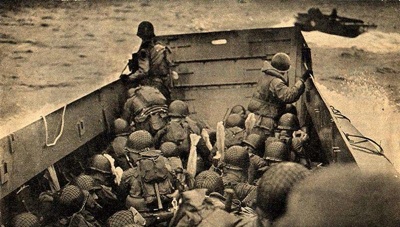 Our World
Our World  Our World
Our World  Pop Culture
Pop Culture 10 Incredible Female Comic Book Artists
 Crime
Crime 10 Terrifying Serial Killers from Centuries Ago
 Technology
Technology 10 Hilariously Over-Engineered Solutions to Simple Problems
 Miscellaneous
Miscellaneous 10 Ironic News Stories Straight out of an Alanis Morissette Song
 Politics
Politics 10 Lesser-Known Far-Right Groups of the 21st Century
 History
History Ten Revealing Facts about Daily Domestic Life in the Old West
 Weird Stuff
Weird Stuff 10 Everyday Products Surprisingly Made by Inmates
 Movies and TV
Movies and TV 10 Actors Dragged out of Retirement for One Key Role
 Creepy
Creepy 10 Lesser-Known Shapeshifter Legends from Around the World
 Our World
Our World 10 Science Facts That Will Change How You Look at the World
 Pop Culture
Pop Culture 10 Incredible Female Comic Book Artists
 Crime
Crime 10 Terrifying Serial Killers from Centuries Ago
Who's Behind Listverse?

Jamie Frater
Head Editor
Jamie founded Listverse due to an insatiable desire to share fascinating, obscure, and bizarre facts. He has been a guest speaker on numerous national radio and television stations and is a five time published author.
More About Us Technology
Technology 10 Hilariously Over-Engineered Solutions to Simple Problems
 Miscellaneous
Miscellaneous 10 Ironic News Stories Straight out of an Alanis Morissette Song
 Politics
Politics 10 Lesser-Known Far-Right Groups of the 21st Century
 History
History Ten Revealing Facts about Daily Domestic Life in the Old West
 Weird Stuff
Weird Stuff 10 Everyday Products Surprisingly Made by Inmates
 Movies and TV
Movies and TV 10 Actors Dragged out of Retirement for One Key Role
 Creepy
Creepy 10 Lesser-Known Shapeshifter Legends from Around the World
10 More Amazing Coincidences
We all love to read about coincidences – and for that reason we have previously published two lists: Top 15 Amazing Coincidences, and Another 10 Amazing Coincidences. Now for your reading pleasure we are happy to announce our third list of amazing coincidences. Enjoy the list and be sure to relate any of your own experiences in the comments.
In the 1890s, the Prince of Wales gave a gift of a golden matchbox to a friend and fellow fox hunter Edward Southern. On a hunt one day, Southern fell from his horse and the matchbox broke from the chain and was lost. Southern had a duplicate made which he left to his son, Sam, upon his death. While traveling in Australia, Sam gave the matchbox to a friend: Mr Labertouche. When he returned to England, Sam discovered that a farmer had found the original matchbox (twenty years after it was lost) when he was ploughing in his field. Sam wrote to his brother who was traveling in America to tell him the good news. His brother read the letter aloud to his traveling companion on the train. By a stroke of bizarre luck, his friend was carrying the duplicate matchbox which had been given to him by Mr Labertouche.
The chances of being struck by lightning are very slim; the chances of being struck by lightning twice (on different days) is seemingly impossible; so what are the odds of being struck by lightning seven times? With our world record holder, Roy Sullivan, the events happened as follows:
1942 – Sullivan was hit for the first time when he was in a lookout tower. The lightning bolt struck him in a leg and he lost a nail on his big toe.
1969 – The second bolt hit him in his truck when he was driving on a mountain road. It knocked him unconscious and burned his eyebrows.
1970 – The third strike burned his left shoulder while in his front yard.
1972 – The next hit happened in a ranger station. The strike set his hair on fire. After that, he began to carry a pitcher of water with him.
1973 – A lightning bolt hit Sullivan on the head, blasted him out of his car, and again set his hair on fire.
1974 – Sullivan was struck by the sixth bolt in a campground, injuring his ankle.
1977 – The seventh and final lightning bolt hit him when he was fishing. Sullivan was hospitalized for burns in his chest and stomach.
His “lightning hats” are on display in New York’s and South Carolina’ s Guinness World Exhibit Hall.
In 1991, Cristina Vernoni, aged 19, was killed at an unguarded railway crossing in Reggio Emilia, Northern Italy. Four years later, her 57 year old father was driving to work on his regular route which took him over the same railway crossing when his car was struck by a train. It was dragged for several dozen yards before the train finally stopped. Even more coincidentally, the driver of the train, Domenico Serafino, was the very same driver who had killed Vernoni’s daughter four years earlier. Investigators said that the death was entirely accidental – ruling out suicide.

In 1951 in the month of March, Dennis the Menace was born… twice. With only three days apart (but an identical debut day), both Hank Ketcham (US) and David Law (UK) created their first comics containing a character with an identical name. The two men were unaware of each others cartoons but when the coincidence was made known to them, they agreed to simply both continue writing their strips without interfering with the other. Even more coincidental was the fact that both Dennis the Menace characters wore striped jerseys (as is evident in the comparison picture above).
On October 15, 1952, Robert Paterson tried to board an Amtrak train from Phoenix to Los Angeles. The conductor told him that Robert Paterson was already onboard. After a quick check, they discovered that both men had tickets. The men were similar height, weight and appearance.
On the way to LA, the train made an emergency stop in Barstow to pick up another passenger: Robert Paterson. The third Mr. Paterson was also similar in appearance to the first two. The train now had three men with the same name and appearance, all headed for LA.
Once they train arrived in Los Angeles, the three Robert Patersons disembarked and went their separate ways. The baggage was unloaded and the train was prepared for the return trip to Phoenix. As the new passengers were boarding, the conductor couldn’t believe his eyes when he saw a familiar name on the passenger list: a fourth Robert Paterson. [Source]
When Norman Mailer began his novel Barbary Shore, there was no plan to have a Russian spy as a character. As he worked on it, he introduced a Russian spy in the U.S. as a minor character. As the work progressed, the spy became the dominant character in the novel. After the novel was completed, the U.S. Immigration Service arrested a man who lived just one floor above Mailer in the same apartment building. He was Colonel Rudolf Abel, alleged to be the top Russian spy working in the U.S. at that time.
Solutions to the popular crossword puzzle in the Daily Telegraph gave a nasty headache to security officers who were responsible for guarding the secrets of the planned invasion of Europe by the allies in June 1944. Members of MI5, Britain’s counter-espionage service who used to wile away their spare moments in this pastime, noticed that some of the clues appeared to give away vital code names invented to cloak the mightiest seaborne attack of all time. The answer to the clue ‘one of the U.S.’ turned out to be, for instance, UTAH, and another, OMAHA – beaches on which the American armies were to land. Another answer was MULBERRY, the floating harbors that would accommodate and supply ships. NEPTUNE was the naval support. Most suspicious of all, there was a clue about ’some big-wig’ which produced the answer OVERLORD, the codeword invented to describe the entire operation. MI5 was in a flap.
Was the Telegraph crossword being used to tip off the Germans? Two officers were sent to Leatherhead, in Surrey, to find out. There they interviewed the compiler of the puzzles, Leonard Dawe, a 54-year old teacher. Why, they demanded, had he chosen those five words for his solutions? Why not? replied Dawe, somewhat indignant. Was there any law against choosing whatever words he liked? Dawe’s patient honesty convinced MI5 that he had no knowledge of the coming D-Day invasion strategy. His crossword solutions were just another of life’s astonishing coincidences. [Source]
When King Louis XVI of France was a child, he was warned by an astrologer to always be on his guard on the 21st day of each month. Louis ws so terrified by this that he never did business on this day. Unfortunately Louis was not always on his guard. On June 21st 1791, following the French revolution, Louis and his queen were arrested in Varennes, whist trying to escape France. On September 21st 1791, France abolished the institution of Royalty and proclaimed itself a republic. Finally on January 21st 1793, King Louis XVI was executed by guillotine.
In an interesting coincidence, Edwin Booth saved Abraham Lincoln’s son, Robert, from serious injury or even death. The incident occurred on a train platform in Jersey City, New Jersey. The exact date of the incident is uncertain, but it is believed to have taken place in late 1864 or early 1865, shortly before Edwin’s brother, John Wilkes Booth, assassinated President Lincoln. Robert Lincoln recalled the incident in a 1909 letter to Richard Watson Gilder, editor of The Century Magazine.
“The incident occurred while a group of passengers were late at night purchasing their sleeping car places from the conductor who stood on the station platform at the entrance of the car. The platform was about the height of the car floor, and there was of course a narrow space between the platform and the car body. There was some crowding, and I happened to be pressed by it against the car body while waiting my turn. In this situation the train began to move, and by the motion I was twisted off my feet, and had dropped somewhat, with feet downward, into the open space, and was personally helpless, when my coat collar was vigorously seized and I was quickly pulled up and out to a secure footing on the platform. Upon turning to thank my rescuer I saw it was Edwin Booth, whose face was of course well known to me, and I expressed my gratitude to him, and in doing so, called him by name.”
Booth did not know the identity of the man whose life he had saved until some months later, when he received a letter from a friend, Colonel Adam Badeau, who was an officer on the staff of General Ulysses S. Grant. Badeau had heard the story from Robert Lincoln, who had since joined the Union Army and was also serving on Grant’s staff. In the letter, Badeau gave his compliments to Booth for the heroic deed. The fact that he had saved the life of Abraham Lincoln’s son was said to have been of some comfort to Edwin Booth following his brother’s assassination of the president. [Source]
In 1898 Morgan Robertson released ‘Futility, or the Wreck of the Titan’. A floating palace sailed from Southampton, England in April, 1898 on a voyage across the Atlantic. She was the biggest and most luxurious liner ever built. The liner was meant to be unsinkable. She was destined for America. But the ship never reached her destination, her hull was ripped open by an iceberg and she sank causing a heavy loss of life as there wasn’t enough lifeboats for the passengers (24 lifeboats for 3000 passengers). The ship was called Titan.
In 1912, a large luxury liner that was built to be unsinkable sailed from Southampton, England to America. She was on her maiden voyage across the Atlantic. The ship struck an iceberg which ripped apart the hull, and the ship sank. There were only 24 lifeboats for the entire ship (about 2200 people), and many people died. This ship was called the Titanic. [Source]

















